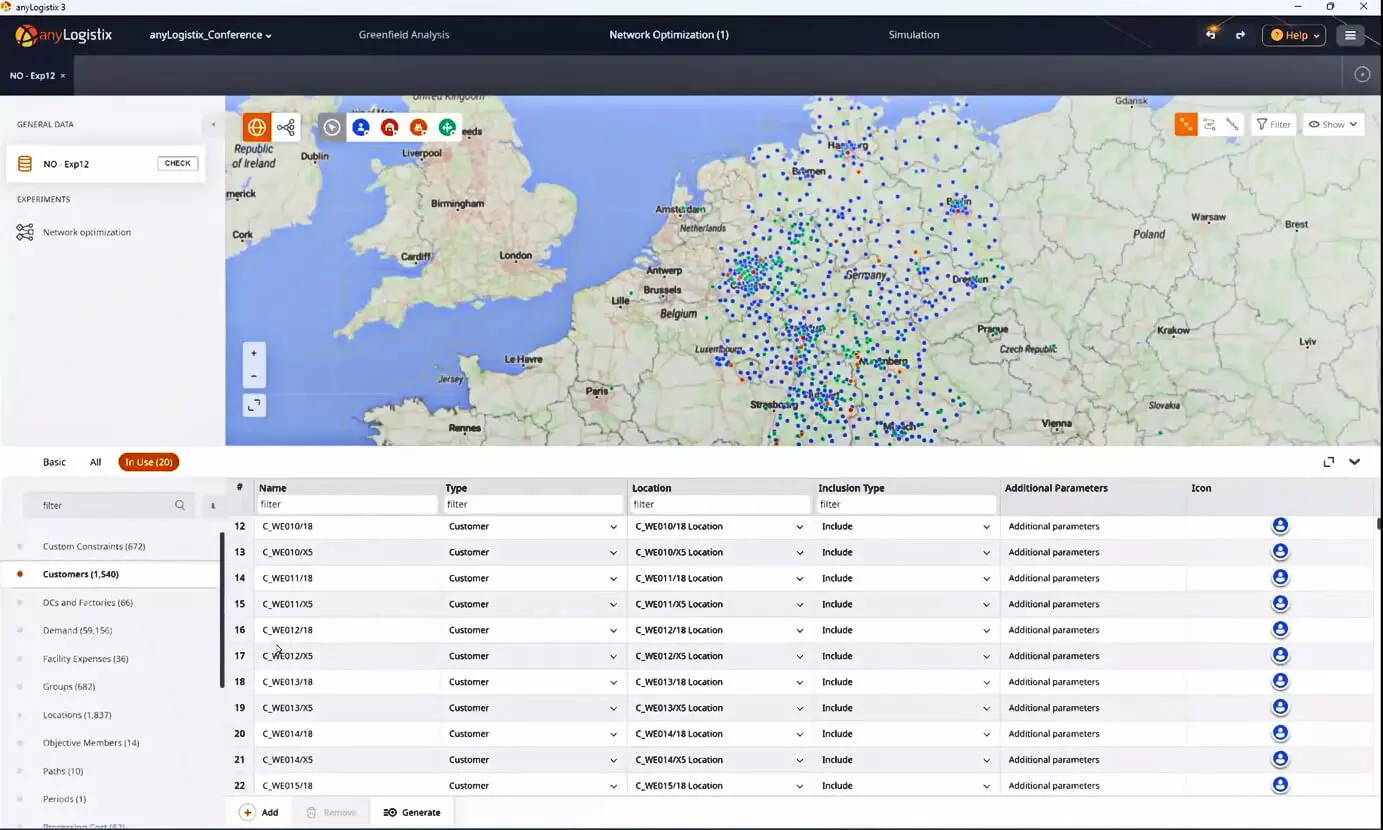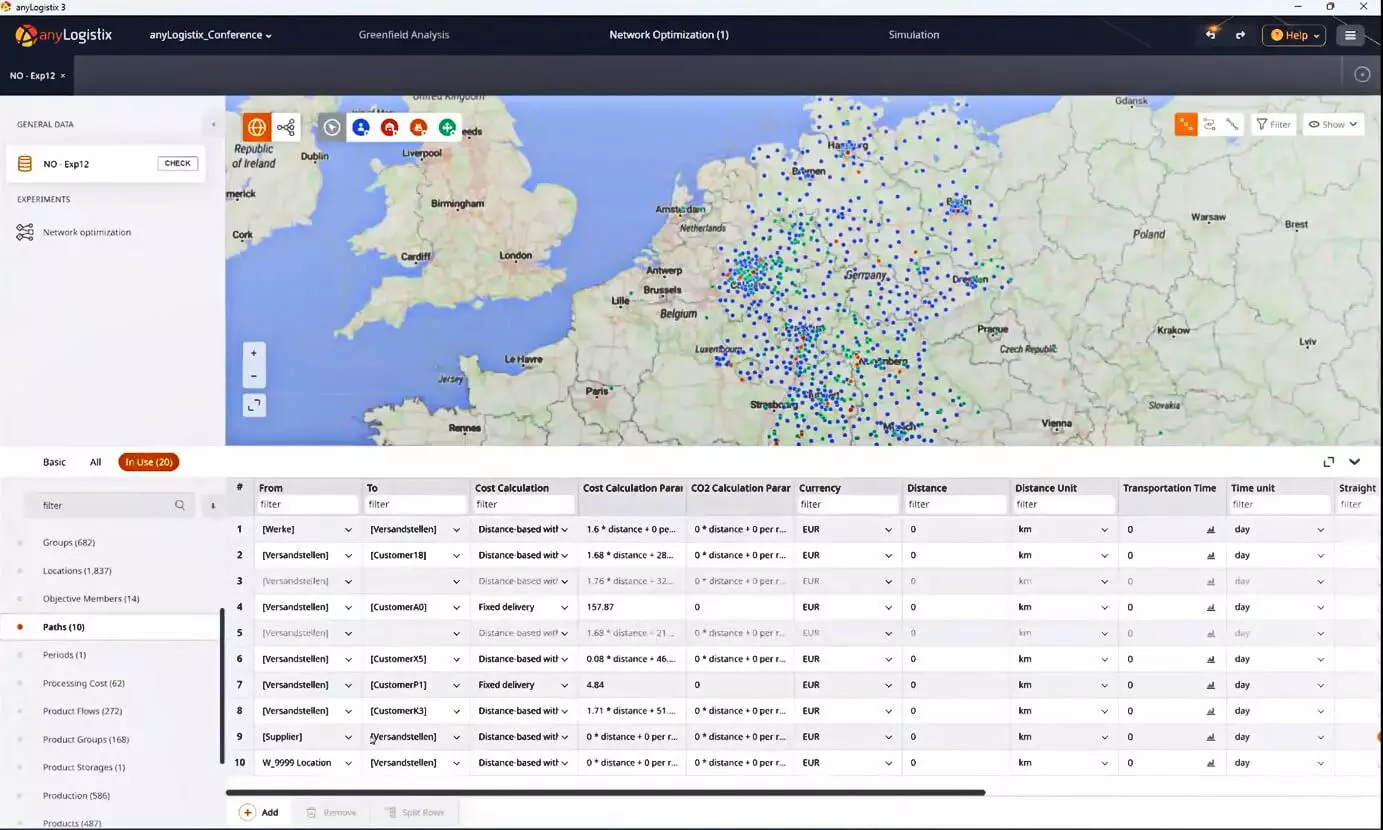

SimPlan AG is a consulting firm focused on simulation-based planning and optimization. Their client, a large German manufacturer of building materials, operates 24 factories and sells 6,000 product items. With around 1,500 customers across all parts of Germany, a strategically optimized supply chain is essential to meet demand seamlessly.
The primary task for SimPlan was to optimize their client’s supply network in Germany, taking into account the projected growth. Specific questions included:
Addressing these questions was critical to helping the client create a cost-effective supply network that could scale to meet growing demands by 2030.
SimPlan used anyLogistix to analyze the client’s network and optimize its configuration. Key steps included:
1. Data Structuring and Simplification
The client’s network involved complex data, including:
To make the model solvable in a reasonable time, SimPlan applied simplifications:
For scenario building, SimPlan used the data on order lines, product hierarchies, factory capacities, customer demand, and shipping logistics.
2. Scaling for Growth
To get a complete scenario, the company also needed to scale the order data for the future. Using growth factors based on sales organization data, SimPlan projected future order volumes, additional pallets, and an increase in total transport weight. This approach led to estimates for the year 2030, which included:
3. Scenario Building and Optimization in anyLogistix


anyLogistix input data example (click to enlarge)
SimPlan imported the data into anyLogistix, and applied the software’s greenfield analysis (GFA) and network optimization features to analyze potential scenarios.

The base scenario depicting the logistics network as is
SimPlan chose anyLogistix for supply chain planning due to its advanced capabilities in simulating and optimizing complex networks. anyLogistix enabled SimPlan to run multiple optimization scenarios and evaluate different network configurations. No other tool provided such level of insights into logistics costs, production flows, and regional service levels. With anyLogistix, SimPlan was able to identify cost-effective scenarios and eliminate inefficient ones.
SimPlan conducted over 50 optimizations, made 15 optimization runs in anyLogistix, and came up with five key scenarios:
1. Centralized Network with 5 Warehouses: GFA, or center of gravity analysis, suggested a centralized network with five central warehouses. This provided better customer coverage but increased transport costs by €3.8 million.

Scenario 1 – five distribution centers from the greenfield analysis
2. Separation of Sales Organizations: SimPlan tested a model where each sales organization independently managed its product transport. This led to a slight cost benefit for one organization but higher overall network costs, making it an unsuitable solution.
3. Decentralized Network with Additional Warehouses: SimPlan added two new distribution centers near Berlin and in the Ruhr region, along with two existing warehouses. This led to €3.3 million in transportation savings.
4. Exclusive Supply from a Single Distribution Center: Supplying customer areas exclusively from one distribution center resulted in increased annual transportation costs by €1.7 million.
5. Hybrid Model: A central structure with two existing warehouses and five distribution centers reduced costs by €1.8 million annually and active shipping points to 7.

Scenario 5 – five distribution centers from the greenfield analysis and two existing warehouses
As a result, the 5th scenario is now under further evaluation by the customer for potential implementation.
Using anyLogistix, SimPlan offered the client to reconfigure its network to support future growth efficiently. The recommended configuration shows significant cost savings and reduces the number of shipping points. This case demonstrates how anyLogistix’s robust simulation and optimization tools drive strategic decisions in supply chain planning.
This case study was presented by Till Fechteler, SimPlan AG, at the anyLogistix Conference 2024.
The slides are available as a PDF.
